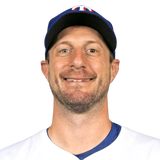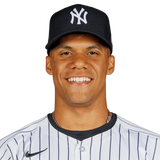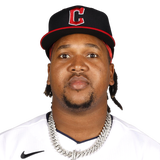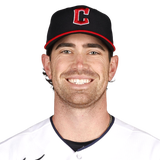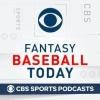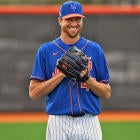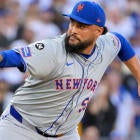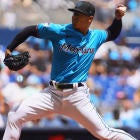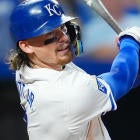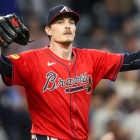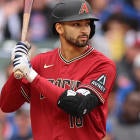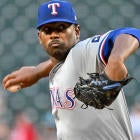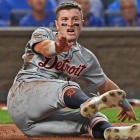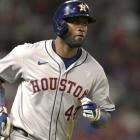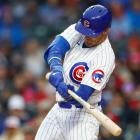Circumstances have changed since our first round of draft prep. We're working with a much shorter schedule now, which of course changes the way certain players are valued. It was supposed to be the year of the pitcher, and the second round is a good spot to try to grab your first one. If Jacob deGrom to the end of the first round, count your blessings, even while he deals with a back injury. If he's not there, Justin Verlander, Walker Buehler, or Max Scherzer could be dominant anchors for your staff.
Consider this your reintroduction to the 2020 draft pool, accounting for all the changes that have taken place since and because of the coronavirus lockdown. Over the span of 20 articles, Scott White and Chris Towers look at the top 200 in Scott's Rotisserie rankings, highlighting the reasons for and against drafting each. We'll present the arguments, you make the choice on Draft Day. .
So if you want a crash course on this year's player pool, particularly in light of more recent events, you've come to the right place. We're going through Nos. 11 through 20 here. And you can find the rest right here: 1-10 | 11-20 | 21-30 | 31-40 | 41-50 | 51-60 | 61-70 | 71-80 | 81-90 | 91-100 | 101-110 | 111-120 | 121-130 | 131-140 | 141-150 | 151-160 | 161-170 | 171-180 | 181-190 | 191-200
| ||||||||||
The Case For: deGrom followed up his incredible 2018 with a nearly-as-incredible 2019, winning his second Cy Young Award, leading the NL in strikeouts ... and still somehow winning just 11 games. He now has three 200-inning seasons in a row and has been at 10.7 K/9 or better in each season. He hasn't been hampered by the juiced ball, in part because deGrom has become one of the premier infield popup artists in the league over the past two seasons — a great way to keep runs off the board. He doesn't have the 300-strikeout potential of Justin Verlander, Gerrit Cole or Max Scherzer, but he seems as safe a bet as anyone to match their workload and lead his league in ERA.
The Case Against: At 31, deGrom isn't as old as Verlander and Scherzer, but he's at the age when a falloff wouldn't be totally shocking. Other than that, it's hard to make a case against him — he's an elite strikeout pitcher who gets ground balls and doesn't walk anyone. What's not to like? Maybe he doesn't quite have the upside of the pitchers typically going ahead of him, but he also doesn't carry as many risks. Though this back issue he's dealing with in camp — minor though it appears today — is at least a small red flag. -Chris Towers
| ||||||||||||
The Case For: After a few frustrating years of health issues and inconsistent power production, Freeman finally delivered the best of what he can be in 2019 — and it was everything we hoped it would be. One area in which he has never disappointed is batting average, his line-drive rate consistently ranking among the best in the game, and that's a difficult category to bolster in later rounds without your team taking a hit elsewhere. First base is riskier than in years past, too, so it's not a bad idea to knock it out early.
The Case Against: Freeman didn't make it all the way through 2019 unscathed. He was playing with bone spurs in his elbow down the stretch, and it limited him in October, requiring offseason surgery. It's probably not something that'll impact his production in 2020, but then again, it hasn't taken much to reduce him from a 35-homer guy to a 25-homer guy in the past. He's also a zero for stolen bases, which are a top priority in the early rounds of standard Rotisserie drafts. -Scott White
| ||||||||||||
The Case For: What's not to love about a perennial Triple Crown threat, a guy who hits .300 while contending for the NL lead in home runs and RBI every year? That's what Arenado has been for basically five straight years now, offering a track record nearly as stable and studly as Mike Trout himself, and as long as he's playing half his games at Coors Field, there's no reason to think it'll be change.
The Case Against: He may not be playing half his games at Coors Field much longer, at least judging by his public criticism of the front office as trade rumors have circulated this offseason. A move out of Colorado wouldn't ruin him, of course, but it might take him out of the conversation for top overall third baseman. It's already debatable with Alex Bregman and Anthony Rendon closing the gap in recent years. -Scott White
| ||||||||||
The Case For: Scherzer might have actually been better than ever in 2019, as he sported his highest strikeout rate and second-lowest walk rate to go along with his best ground-ball rate since 2011. Relative to league average, Scherzer had his best FIP ever, and his league-adjusted ERA wasn't far from the best we've seen of him. The ageless wonder actually had his highest average fastball velocity ever, to boot. At the very least, Scherzer isn't getting worse, and his price is getting cheaper.
The Case Against: Of course, his price is getting cheaper because, for the first time, we actually saw him look mortal. The performance was where we hoped it would be, but a back injury in the second half limited him to just 27 starts, his fewest since his days as a Diamondbacks prospect back in 2008. Scherzer didn't really pitch like himself upon returning from the injury, though he mostly bounced back in the playoffs, racking up 36 strikeouts in 30 innings with a 2.40 ERA en route to a World Series title. Still, Scherzer is 35 years old and, for the first time ever, reminded us of his age in the second half of last season. Pitchers don't generally get healthier the older they get, so that could have been the beginning of the end of his time as the sport's dominant pitcher. -Chris Towers
| ||||||||||||
The Case For: Here's the entire list of players with more home runs before their age-21 season than Soto: Mel Ott. That's it. That's the list. Put another way, Soto won't be as old as Pete Alonso is right now until 2024. Soto's dominance at his precocious age is basically unprecedented and gives him one of the brightest futures in the game. We're talking about a potential Albert Pujols-level talent who then also went out last season and decided to steal 12 bases. It's hard to be a contender for the No. 1 pick if you don't have the potential for big steal numbers, but Soto could absolutely mash his way there.
The Case Against: He's not quite there yet. You have to pick nits in this exercise, and in Soto's case, it's just that he hasn't quite turned into that elite masher yet. He's a good power hitter, but not an elite one; he's a good base stealer, but not an elite one; he hits for a good average, but not an elite one. These are thin criticisms for an improving player, but when he's going ahead of the likes of Freddie Freeman and J.D. Martinez, according to ADP, you can see where he might fall short. -Chris Towers
| ||||||||||||
The Case For: For most of the last three seasons, Ramirez has been worth his current cost. Even in a difficult 2019, his combination of power and speed made him stand out — he was one of just five players with at least 23 homers and 24 steals. It's hard to see things being much worse for Ramirez in 2020 than they were last season, and it was his worst season since 2016, at least, so that's not too bad.
The Case Against: Of course, we have seen how bad things can go for Ramirez when they go wrong. He hit just .214/.309/.325 through the end of June as he tried to compensate for increased shifting against him and ended up sapping his swing of the power that fueled his breakout. The margin for error seems to be pretty slim for Ramirez, and he might be more of a headache than he's worth as a second-round price tag, especially if he turns out to be not an elite base-stealer. -Chris Towers
| ||||||||||
The Case For: Fresh off his second Cy Young and back to being a perennial contender for the award, Verlander shows no signs of letup entering his age-37 season. At a time when few pitchers are making it through six innings consistently, he routinely goes seven or more, having led the majors with 229 last year, and it's that workload advantage combined with his dominant-as-ever stuff that puts him in rare company at starting pitcher. There's also the possibility your leaguemates will overreact to the lat strain he suffered early in spring training, allowing you to snag him at a discount.
The Case Against: Did I mention he's entering his age-37 season? That's ancient by any player's standards, but particularly one who lives on 97-mph fastballs and has more than 3,000 innings (playoffs included) to his name. At some point, it's all going to come crashing down for Verlander, and the spring injury may be start. Plus, with the regime change in Houston, who knows if he'll be getting the same oversight that allowed him to recapture his once dominant form? -Scott White
| ||||||||||
The Case For: Buehler basically didn't have a spring training as the Dodgers tried to limit his workload last season, which might explain the 5.22 ERA and 7.4 K/9 through six April starts. From that point on, Buehler was pretty much everything we could have hoped for, posting a 2.88 ERA with 191 strikeouts in 153 innings over his final 24 starts — i.e., ace production with an ace workload to match. Buehler answered pretty much every question you might have had about him in 2019, and at just 25, he's only going to get better from here.
The Case Against: It's really hard to come up with a case against Buehler. There were better pitchers in 2019, but not many. If you have to make a case against him — and I do! — it has to revolve around price. He's going off the board as the No. 4 starting pitcher, just one spot behind Max Scherzer in ADP. As good as Buehler was last season, he hasn't yet shown Scherzer levels of upside, so you're counting on him to take yet another step forward. He may; he's certainly talented enough. But it's not guaranteed. -Chris Towers
| ||||||||||
The Case For: Even without the benefit of a serviceable changeup, Bieber figured out a way to stop the bleeding against opposite-handed hitters, allowing his strengths to take center stage. His curveball caught up to his slider to give him two plus breaking balls, and he's just on another level as a strike-thrower, his 1.7 BB/9 ranking tops in the AL. That sort of efficiency has already helped establish him as one of the most durable pitchers in baseball, taking on a workload beyond that of even a typical ace. Best of all, his FIP (3.32), xFIP (3.23) and SIERA (3.36) are all dead in line with his ERA (3.28), suggesting it wasn't a fluke.
The Case Against: Of course, there are other measures that suggest it may have been a fluke. Bieber gave up some of the hardest contact of any starting pitcher last year, so it's fair to speculate that more damage should have been done on batted balls. The trouble against lefties could rear its ugly head again, and the heavy workload so early in his career could catch up to him. -Scott White
| ||||||||||||
The Case For: For years, Rendon was the third baseman you settled for once the elite guys were off the board, but he joined that elite crew in 2019. Rendon was able to sustain his elite contact ability while increasing his launch angle, leading to a mid-career power breakout. And the advanced stats back it up — his .413 wOBA was actually just below his .418 expected wOBA, per StatCast data, and he ranks very well by average exit velocity and hard-hit percentage. And now he gets to either bat behind or in front of Mike Trout, creating arguably the best two-man lineup combo in baseball. Runs and RBI should be plentiful toward the top of the Angels lineup.
The Case Against: Was Rendon just a juiced ball guy? His average exit velocity was actually slightly down from 2018, while his hard-hit rate barely moved. It seems like a case of some relatively minor optimization leading to a big increase in overall production, and it might be tough to replicate that. The floor is incredibly high here, but there's a reason Rendon was never a borderline first-rounder before this season. -Chris Towers









